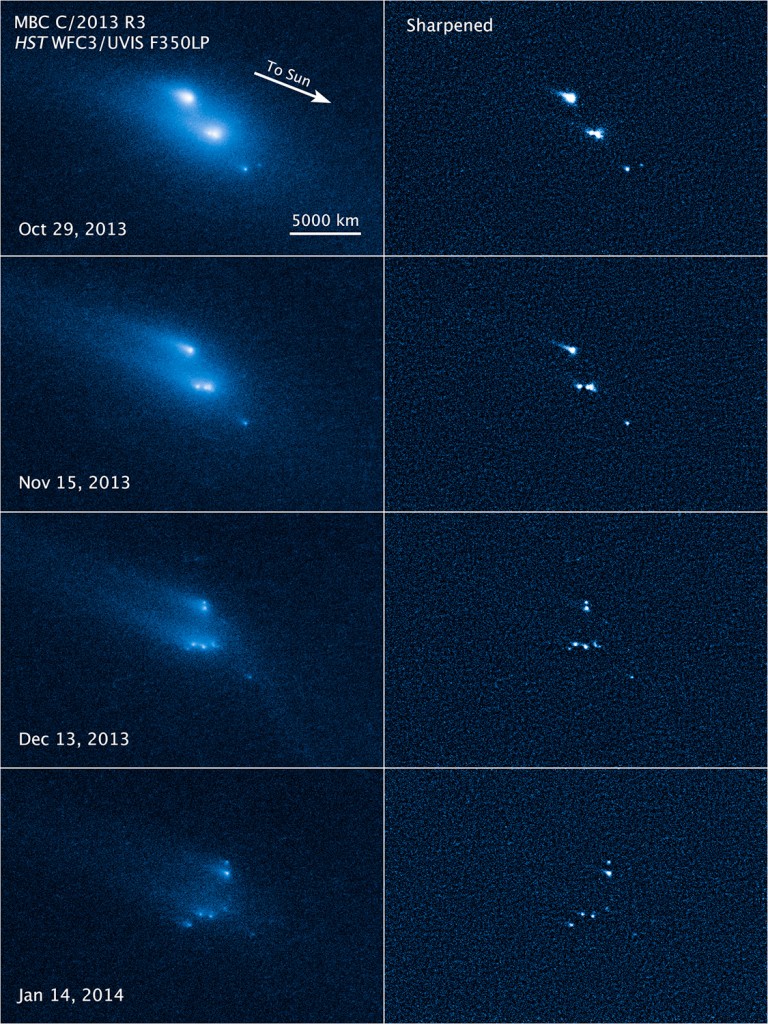Crumbling Asteroid a First, Astronomers Say
Astronomers on the Big Island recently assisted in the first-ever recording of the break-up of an asteroid.
The asteroid was observed breaking into as many as 10 smaller pieces over a period of several months.
The crumbling asteroid named P/2013 R3 was first observed as a fuzzy-looking object by sky surveys from Maui and Arizona in mid-September.
A follow-up look by the W.M. Keck Observatory atop Mauna Kea on Oct. 1 indicated it was three bodies moving together inside an envelope of dust nearly the size of Earth.
“The Keck Observatory showed us this thing was worth looking at with Hubble,” said David Jewitt, a University of California at Los Angeles astronomer overseeing the forensic study in the sky.
NASA’s Hubble Space Telescope revealed there were actually 10 embedded objects, each with comet-like dust tails. Jewitt said the four largest rocky fragments were up to 400 yards in diameter, about four times the length of a football field.
Fragile comets, comprised of ice and dust, have been seen falling apart as they near the sun, but nothing like this had ever before been observed in the asteroid belt, NASA scientists said in a statement issued today.
“This is a rock, and seeing it fall apart before our eyes is pretty amazing,” Jewitt said.
NASA said data from Hubble showed the fragments drifting away from each other at a leisurely 1 mph. The asteroid began coming apart early last year, but new pieces continue to reveal themselves, the most recent images show.
Astronomers say it is unlikely the phenomenon is the result of a collision with another asteroid, as that would have been instantaneous and violent in comparison.
Debris from such a high-velocity smashup would also be expected to travel much faster than observed.
NASA said it is also unlikely the asteroid is coming apart due to the pressure of interior ices warming and vaporizing.
This leaves a scenario in which the asteroid is disintegrating due to a subtle effect of sunlight, which causes the rotation rate of the asteroid to gradually increase.
“Eventually, its component pieces — like grapes on a stem — succumb to centrifugal force and gently pull apart,” the statement said. “The possibility of disruption in this manner has been discussed by scientists for several years, but never reliably observed.”
Scientists said for this scenario to occur, P/2013 R3 must have had a weak, fractured interior — probably the result of numerous relatively minor bumps by other asteroids. Most small asteroids are thought to have been severely damaged in this way.
They said P/2013 R3 is likely the byproduct of just such a collision sometime in the last billion years.
With a previous discovery of an active asteroid named P/2013 P5 spouting six tails, astronomers are finding more evidence the pressure of sunlight may be the primary force causing the disintegration of our solar system’s small asteroids, those that are less than a mile across.
P/2013 R3’s remnant debris, which weighs an estimated 200,000 tons, will in the future provide a rich source of meteoroids. NASA said most will eventually fall into the sun, but a small fraction of the debris may one day blaze across our skies as meteors.

Photos taken by the Hubble Space Telescope show the asteroid in various stages of disintegration. NASA images.










